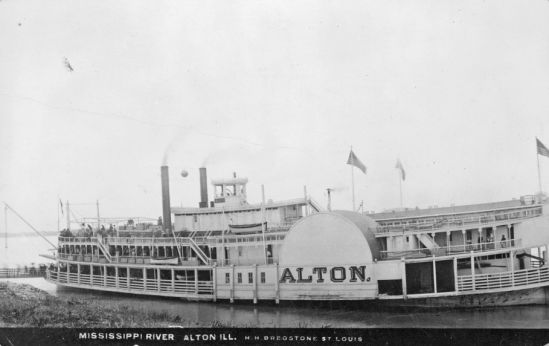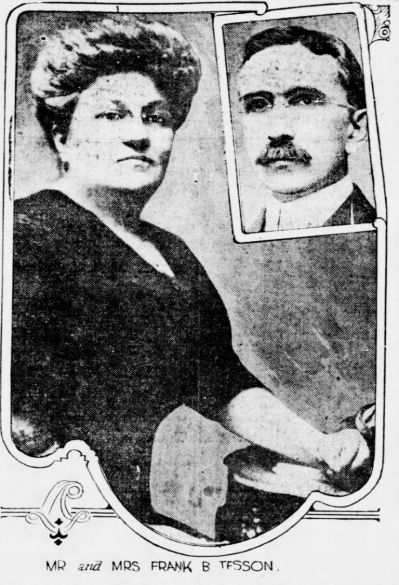
Neighbors Making History: The Tesson Family - Life and Death on the Water
(written by Jeff Rand, retired Adult Services librarian)

La Crosse Tribune 7 May 1915
One hundred and nine years ago, this is the front page that La Crosse residents saw when they opened their daily newspaper. Despite the optimistic headline, there were only 764 survivors. Out of the 1,959 people on board the Lusitania, 1,195 men, women, and children died, including 128 Americans. One of them was a native of La Crosse – Frank B. Tesson.
His father, Frank H. Tesson, was a veteran boat pilot and captain during the heyday of steam boating on the Mississippi River. Tesson Sr. devoted his entire working career to the waters of the big river in the country’s heartland, while Tesson Jr. met his death on distant seas in one of the most well-known disasters of the 20th century.
Tesson Sr. was a native of Portage des Sioux, Missouri, on the west bank of the Mississippi River, and was said to be a descendant of a Parisian French family. He spoke only French until he began working as a cabin boy on a steamboat at the age of 14. His wife, Emily Barncastle, was from Galena, Illinois, where she attended a private school that was next door to the home of Ulysses S. Grant. Emily recalled seeing Mr. and Mrs. Grant frequently during her childhood. Tesson and Barncastle married in 1856. Their first two children, Bertha, and John, were born in Illinois. Frank Barncastle Tesson was born in La Crosse on January 14, 1866. They later had another daughter, Lillian.
Tesson Sr. was a riverboat pilot for the Northwestern Union Packet Co. The family lived at several places in La Crosse with several documented addresses in or near downtown from 1866 until 1873. With a short residence in Galena, the family made their final move in 1875 to Alton, Illinois, across the Mississippi River from St. Louis.
Tesson Sr. became one of the pilots of the new 224-foot, 220-passenger steamboat Spread Eagle in 1880. He would later command other steamboats in the river trade, including the Bald Eagle, Dora, Iowa, Richardson, Belle of Calhoun, and India Givens. He was still working on the river, at the age of 73, when high wind slammed into a door, knocking him from the pilot house down to the deck. He suffered gashes in his head and was unconscious for a time. After recovering from his injuries, the 74-year-old Tesson Sr., oldest active pilot on the Mississippi River, took over the excursion steamer Alton. In June 1908, a man on a flatboat near Venice, Illinois, apparently upset by the wake from steamers running close to the shore to avoid strong currents, fired into the pilot house of the Alton. One bullet grazed Tesson Sr.’s shoulder and another came close to his head. Another river pilot was fired on the same night.
Not long after this incident, Tesson Sr. had to retire because of his declining health after sixty years working on the Mississippi River. From his sickbed in the weeks before he died, he apparently named every boat that passed by on the river just by the sound of its whistle or engines. Captain Frank H. Tesson died at his home in Alton, Illinois, in July 1909, at the age of 74. He was born next to the river, worked on the river, and died next to the river.

Frank H. Tesson's last boat - photo courtesy of UW-La Crosse Historic Steamboat Photographs Collection
Frank B. Tesson would have been about eight years old when the family moved away from La Crosse in 1874. Tesson Jr. was an honor roll student and graduated from Alton (IL) High School in 1883. He got a job in the shoe department of the Famous store, later called Famous-Barr Co., in St. Louis.
On August 28, 1895, Tesson Jr. married St. Louis resident Alice E. Lowe. Alice was three years older than Frank, and she had three sons from a previous marriage. By 1900, they were living in Pittsburgh where he continued to work in the shoe business. They were living in Philadelphia in 1904. Frank and Alice moved to New York City in 1905, where Frank was a buyer in the shoe department for the John Wanamaker department store. Wanamaker stores were known for the style and quality of their goods, and the company sent buyers to Europe every year in search of quality items to stock in their stores. This practice would indirectly prove fatal to Tesson Jr.

St. Louis Post-Dispatch 9 May 1915
War broke out in the summer of 1914 between Germany and its allies and France, Great Britain, and their allies. The United States, under President Woodrow Wilson, tried to walk the tightrope of neutrality to avoid being sucked into what would become known as the First World War. As an island nation, Great Britain had always been reliant on maritime trade for raw materials and imported goods. Shipping was its lifeline during both war and peace, and the Royal Navy was built and maintained to preserve that lifeline.
The German navy was frustrated because its U-boats (submarines) were seldom able to engage Royal Navy warships due to the distance from their bases to British naval ports and the effective British sea defenses. Because the British were blockading German maritime trade, the Germans felt justified in attacking merchant shipping supplying the British. From January to September 1915, German U-boats conducted unrestricted attacks on shipping in the British Isles.
Despite the danger, civilian cruise ships continued to sail in those waters. In early 1915, Germany sent a formal notice to the State Department of the United States declaring the area around the British Islands a war zone. This was an attempt by Germany to avoid civilian casualties from neutral countries. Because of human error, a German warning to commercial ships traveling into the war zone was not published in American newspapers until May 1.

New York Tribune 1 May 1915
Tesson Jr. wrote letters to his mother and a friend in Philadelphia telling them he was taking Alice with him on a buying trip in London. It was such a last-minute voyage that they were not even on the passenger list for the R.M.S. Lusitania.
On May 1, 1915, the Cunard liner Lusitania, under Captain William Turner, left New York with 1,388 passengers bound for Europe. Most of the passengers were not worried about an attack because they believed the Lusitania could outrun German U-boats, and they expected Royal Navy warships to provide protection close to Great Britain. What they did not know was that six of Lusitania’s 25 boilers were not used during the voyage to save coal, and the Royal Navy lacked the resources to provide escorts in the Irish Sea and St. George’s Channel. It was a clear day when the Lusitania approached the coast of Ireland, and, despite warnings of submarine activity in the St. George’s Channel, Captain Turner put his ship on a slow, straight course.

R.M.S. Lusitania leaving New York harbor, 1 May 1915 - photo courtesy of Library of Congress
At about 2:10 p.m., German Captain Walter Schwieger’s U-20 fired one torpedo into the Lusitania, and the ship quickly started to sink as the crew struggled to launch lifeboats. A massive secondary explosion spelled doom for the massive ship. The stricken ship listed to one side so sharply that most lifeboats could not be launched. The first lifeboat to be launched capsized, throwing its cargo of mostly children and some women into the water. Other lifeboats and many people were sucked down into the ocean when the great liner sank only 15 to 20 minutes after it had been struck. It went down in 315 feet of water with its bow striking the seafloor even as the stern rose high above the water. Those who did survive owed their lives to lifebelts that kept them afloat until they were rescued.
Some well-known Americans were among those who lost their lives, including Alfred Vanderbilt, Charles Frohman, Lindon Bates, Jr., Justus M. Forman, Elbert Hubbard and his wife, Captain J. B. Miller, Herbert S. Stone, Charles Klein, Lothrop Withington, and Frederick Stark Pearson. All over the country, families of lesser-known Americans were anxiously awaiting news of their loved ones. Communication between a St. Louis newspaper and the Wanamaker company in New York, about seven days after the sinking, confirmed that Frank and Alice Tesson were saloon passengers (First Class) on the Lusitania.
Frank and Alice Tesson’s bodies were never found. On May 17, 1915, there was a memorial service for them in the Chambers-Wylie Memorial Presbyterian Church in New York City. Frank B. Tesson was 49 years old when he died, and his wife, Alice, was 52 years old.

La Crosse Tribune 19 May 1915
WANT TO LEARN MORE?
Check out Jeff's full article here
